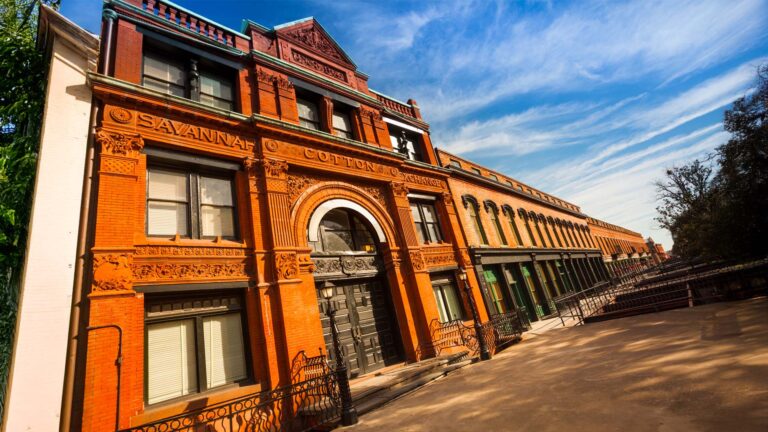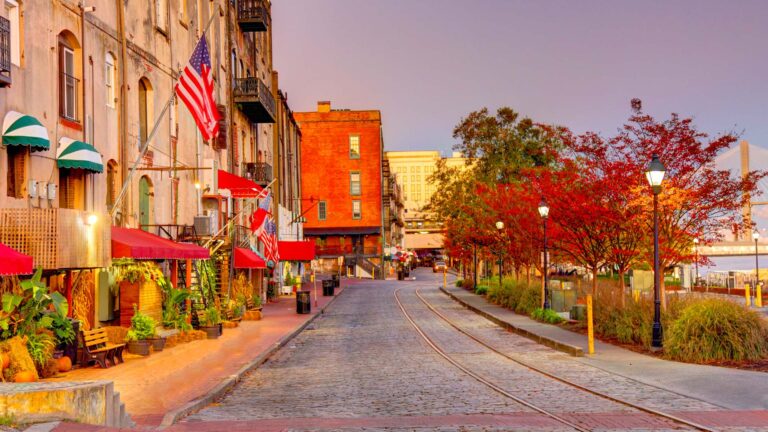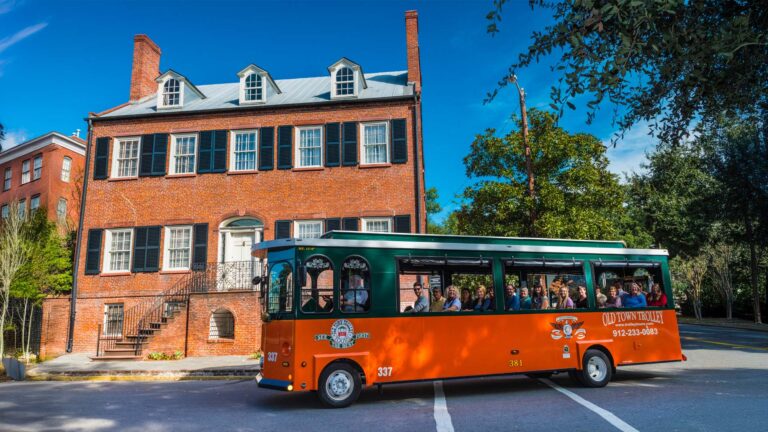Savannah is filled with exceptional historical sites that highlight its rich Savannah history. Some of the must-visit locations include the Davenport House Museum, which showcases colonial-era life; Fort Pulaski National Monument, a Civil War fort with well-preserved defenses; and the Owens-Thomas House & Slave Quarters, offering a sobering look at antebellum society and enslaved peoples. Historic squares such as Wright Square and Johnson Square provide peaceful spaces surrounded by significant architecture. The American Prohibition Museum® also adds a unique angle on Savannah’s past. Using the Old Town Trolley Tours® allows easy access to these landmarks while enjoying expert storytelling.

What Makes Savannah History So Unique and Worth Exploring?
The history of Savannah, GA, is more than just something stored in museums; it lives in the city’s layout, architecture and green spaces. The Oglethorpe Plan, a unique 18th-century design, shapes how the city feels and functions today. Visitors can explore centuries-old homes, historic squares and quiet parks that tell stories of colonial life, the Revolutionary War and the Civil War. Savannah welcomes all kinds of travelers who want to experience its deep roots firsthand. This guide will help you navigate the top things to do in Savannah for history buffs.
Savannah
History
Why Is Savannah a History Buff’s Paradise?
Savannah stands out as a top destination for history enthusiasts because of its remarkably preserved city plan and rich past. The history of Savannah, GA, reflects its role in major events, from its founding as a British colony in 1733 by James Oglethorpe to its involvement in the American Revolution, and later the Civil War.
The city was carefully designed using the Oglethorpe Plan, a distinctive 18th-century layout that features a network of 24 historic squares surrounded by parks, churches and homes. This design not only served defensive purposes but also fostered a strong sense of community that remains today. Savannah’s elegant architecture also shows the wealth generated by its cotton trade during the antebellum period. Preservation efforts have ensured many historic buildings and green spaces have survived urban development, making the city a living museum.
More on Savannah During the Colonial and Revolutionary War Era
As a British general and social reformer, James Oglethorpe planned Savannah as a refuge for debtors and the poor, creating a unique and orderly city layout that balanced defense with community life. Early settlers faced many challenges, including harsh conditions, Native American relations and the establishment of agriculture. Despite these growing pains, Savannah quickly became a thriving port and center for trade.
During the Revolutionary War, Savannah played a significant role as a strategic southern city. It was occupied by British forces in 1778, leading to battles that shaped the region’s future. The city’s residents experienced hardship and conflict, but also resilience. Today, visitors can explore sites that reflect this era, gaining insight into the history of Savannah, GA, during America’s fight for independence. The city’s colonial past remains a cornerstone of its identity and offers rich stories for history buffs to discover.

How Did the Antebellum and Civil War Eras Shape Savannah’s History?
The history of Savannah, GA, during the antebellum period is closely tied to the city’s booming cotton economy. Known as the Cotton Kingdom, Savannah became a wealthy port city, thriving on the trade of cotton and other goods. This wealth fueled the growth of grand homes and public buildings, many of which still stand today, showcasing stunning examples of antebellum architecture.
When the Civil War broke out, Savannah found itself in the middle of intense conflict. In 1864, General William Tecumseh Sherman captured the city during his famous March to the Sea. Unlike many other southern cities, Savannah was spared from widespread destruction. This allowed much of its rich architectural legacy to survive, preserving an important part of Savannah history for future generations.
Today, visitors can still see the impact of this era in the city’s historic buildings and streets, a testament to Savannah’s resilience through prosperity and turmoil.
Savannah
Historic Sites

Which Historical Sites and Museums Should You Not Miss in Savannah?
Savannah’s rich past comes to life in its many historic house museums, each offering a unique window into the history of Savannah, GA. The Davenport House Museum is a beautifully preserved example of early 19th-century Federal architecture, showcasing the lifestyle of Savannah’s residents in the early 1800s. Nearby, the Owens-Thomas House & Slave Quarters reveal a complex story of antebellum wealth and the harsh realities of slavery, providing valuable insight into the social history of the city.
The Mercer Williams House Museum, famous for its architecture and ties to Savannah’s social elite, offers a fascinating glimpse into the city’s cultural past. The Andrew Low House tells the story of one of Savannah’s prominent cotton merchants and his family’s role in the city’s growth. Finally, the Green-Meldrim House, a striking Gothic Revival mansion, now serves as the headquarters for the Episcopal Diocese of Georgia but stands as a testament to Savannah’s architectural and historical heritage.
Additionally, the American Prohibition Museum® and the Savannah Pirates and Treasure Museum™ offer glimpses into two of the most fascinating periods of history. The American Prohibition Museum® teleports guests back to the Roaring Twenties and days filled with bootleggers, the temperance movement and more in the nation’s only Prohibition-era museum. The Savannah Pirates and Treasure Museum™ is equally engaging for visitors who want to learn about piracy beyond Hollywood portrayals. Both should be included on every history buff’s Savannah itinerary.
Which Significant Squares and Cemeteries Reveal the Rich History of Savannah?
Savannah’s historic squares and cemeteries offer some of the most meaningful insights into the history of Savannah, GA. Each square was originally designed as a public gathering space and today serves as a peaceful spot filled with monuments, fountains and centuries-old trees. Johnson Square is the oldest and largest of these squares. It has been a central part of Savannah’s civic life since 1733 and features a monument honoring James Oglethorpe, the city’s founder. Not far away, Wright Square offers a glimpse into Savannah’s early legal and political history, with markers commemorating the city’s first mayor and other important figures.
The Colonial Park Cemetery holds stories from the city’s earliest days, with graves dating back to the 1700s. Visitors often reflect on the lives of the early settlers and Revolutionary War soldiers buried there. For a more serene and scenic experience, Bonaventure Cemetery stretches along the Wilmington River, famous for its beautiful statuary and moss-draped oaks. This cemetery also reflects Savannah’s Victorian-era past and holds the graves of many notable locals.
Savannah
Historic Experiences

How Can You Experience Savannah’s History in an Immersive Way?
Savannah offers a variety of immersive historical experiences that bring the history of Savannah, GA, vividly to life for visitors of all interests and ages. Exploring the city on a Guided History Walking Tour lets you step back in time as knowledgeable guides share stories of Savannah’s founding, key events and local legends. These tours weave together the Savannah history found in its streets, architecture and public squares, making history feel personal and tangible.
For those who prefer to cover more ground with ease, the Old Town Trolley Tours® provide a convenient hop-on, hop-off experience. Friendly and well-informed conductors narrate as you explore the city’s historic districts, landmarks and parks. The trolley’s route highlights the layers of history of Savannah, GA, while allowing you to explore at your own pace, pausing to absorb the charm of each neighborhood.
For a darker glimpse into the past, Ghosts & Gravestones® offers an atmospheric evening tour. Combining chilling ghost stories with visits to haunted locations, this tour reveals the supernatural side of Savannah’s history. Guests hear about the city’s mysterious past through engaging storytelling while touring sites linked to paranormal activity, uncovering the eerie tales hidden beneath Savannah’s historic veneer.
If you want an even more hands-on approach to Savannah’s mysterious side, the Ghost Hunters of Savannah® Paranormal Investigation invites you to join real investigations using professional ghost-hunting equipment. This unique experience dives deep into the eerie history of Savannah, GA, at the convenience of one location, making it perfect for thrill seekers and history buffs alike who want to connect with the past in an unforgettable way.
It would be remiss not to mention once more the American Prohibition Museum®, where you can learn about the Prohibition era through interactive exhibits and immersive storytelling. This museum captures an important chapter in Savannah’s past, exploring the social and cultural impacts of the 1920s nationwide while placing Savannah’s role in the broader historical context.
And again, families and adventure seekers will enjoy the Savannah Pirates and Treasure Museum™, an engaging attraction that combines historical facts with fun pirate lore opening in 2025. It offers hands-on exhibits, treasure hunts and stories of the pirates who once sailed the Georgia coast, blending entertainment with Savannah history in a way that captures imaginations of all ages.
Finally, reenactments and living history events throughout the city provide visitors with the chance to witness history unfold before their eyes. Actors portray significant moments from Savannah’s colonial days through the Civil War, giving a deeper understanding of the history of Savannah, GA, that shaped the city’s unique identity.
Together, Savannah’s forts and churches offer visitors an expansive view of Savannah history, blending military strategy, faith and community spirit into a fascinating journey through time.

FAQs
Savannah holds a special place in Civil War history, with well-preserved forts, cemeteries and buildings telling the story of that era. Fort Pulaski, just outside the city, played a crucial role during the war, and visitors can explore its thick walls and historic cannons. Savannah was also occupied by Union forces late in the war, which left many buildings intact, unlike other southern cities. Walking through neighborhoods like the Victorian District reveals architecture from the period, while historic cemeteries offer insight into those who lived through the conflict. The city’s commitment to preserving this era makes Savannah an essential destination for those interested in Civil War history.
The Oglethorpe Plan is the distinctive urban design created by James Oglethorpe when founding Savannah in 1733. This plan laid out a grid of wide streets intersecting with public squares, each surrounded by residential and civic buildings. This layout was revolutionary in colonial America, promoting community, defense and green space. Today, the Oglethorpe Plan remains visible and preserved, making Savannah unique among American cities. Walking tours often focus on this layout, showing how the design has influenced the city’s growth and preserved its charming character. Understanding the Oglethorpe Plan is key to appreciating the history of Savannah, GA.
Yes, many guided walking tours specialize in Savannah’s rich Savannah history, offering immersive stories about the city’s founding, architecture and role in major historical events. The Historic Savannah Foundation provides expert-led tours focusing on the preservation and heritage of key sites. The Ghosts & Gravestones® Tour blends history with ghost stories for a thrilling look at the city after dark. These walking tours are ideal for visitors who want to connect closely with the city’s past and explore neighborhoods that shaped its identity. Several tours include visits to registered historic landmarks, ensuring an educational and engaging experience.
Historic homes play a big role in telling the history of Savannah, GA, and many are open to the public as museums. The Mercer Williams House Museum offers a glimpse into 19th-century life and the stories behind its famous residents. The Davenport House Museum preserves one of the oldest colonial homes, showcasing period furnishings and architecture. Visitors can also tour the Andrew Low House and Green-Meldrim House, both rich with historical significance. These homes often feature detailed exhibits about Savannah’s social history and the people who lived there. Many are accessible via Old Town Trolley Tours® or walking routes.
Savannah was a strategic city during the American Revolutionary War, serving as a key port and site of several important battles. It was occupied by British forces for much of the war, and the Siege of Savannah in 1779 was one of the conflict’s bloodiest encounters. The city’s historic districts and burying grounds hold monuments and graves from this era, connecting visitors directly with its Revolutionary past. Sites like Johnson Square and the nearby Fort Pulaski illustrate Savannah’s military and colonial importance. Learning about these events offers a deeper understanding of the history of Savannah, GA, and its place in the founding of the United States.